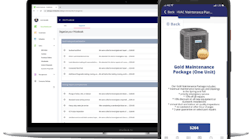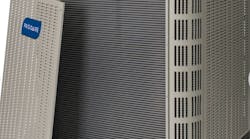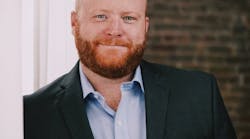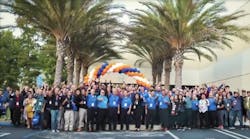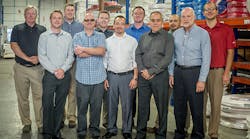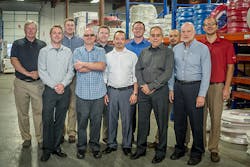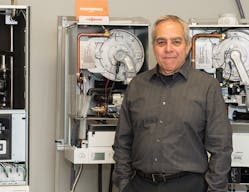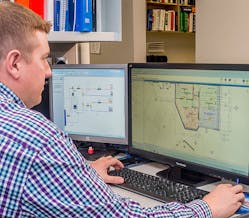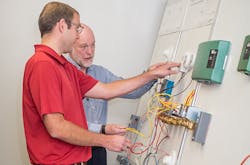Last year, Ferguson hydronics managers met to come up with a strategy to build the company’s hydronics side of the business. The strategy is a two-step process: increase the efficiency of the existing employees that are experts in hydronics by creating a central design team and train quality hydronics recruits via Ferguson’s Design Center, which focuses on residential hydronics and is based in Denver.
Even though the meeting of the hydronics minds happened one year ago, Ferguson began tapping into the hydronics market years earlier. First, Dennis Bellanti was hired 13 years ago to be the hydronics manager of Ferguson. He started a hydronics division, based out of the Denver location. Ferguson has a total of 22 locations in Colorado, and Bellanti has done work for each.
Also, specific to Ferguson’s Denver location, this group was the first to develop a Design Center based on residential hydronics installations.
“Ferguson is strong in plumbing, but they needed more strength in hydronics at the time, so I was hired 13 years ago to build the department and the Design Center,” explains Bellanti. “My job was to take hydronics to a serious endeavor. We were able to get a significant market share of hydronics throughout the years and we have been able to maintain it, too.”
We were able to get a significant market share of hydronics throughout the years and we have been able to maintain it too.—Dennis Bellanti
Ferguson’s hydronics division based in Denver has extensive experience in residential and light commercial design, including projects such as root warming, breweries, biomass fuels, snow melting pits, waste heat recovery and thermal solar.
“Right after we put the Denver Design Center into action, our Chicago group headed by the local hydronics manager, Marco Spallasso, put a similar Design Center together to support our commercial customers,” says Bellanti.
Since the Chicago group has a strong background in commercial design and support and the Denver group excels in residential, it made sense to create two groups operating under the same principles of education and employee opportunity.
“Having these two Design Centers has given us the opportunity to offer our customers expertise in both sectors,” explains Bellanti.
On the residential side of the hydronics business, there is also strong growth in sales in the New England area and recently Ferguson has put an emphasis on growing business in that area by the acquisition of Redlon & Johnson in March of 2015.
“They have 10 locations in Maine and New Hampshire,” says Bellanti. “It is a market we realize is huge for hydronics, so we are excited to have an opportunity to have an impact and we are seeing strong growth in our sales.”
Central Design Team
Once working for Ferguson, the first step Bellanti took was to make the Denver hydronics group larger — find recruits interested in learning about hydronics — to serve the state of Colorado.
“It was pretty hard for us to find qualified hydronics people to replicate what we have in the Denver area throughout the entire state of Colorado, let alone the U.S., so we decide to make the Denver hydronics group larger to serve Colorado,” says Bellanti.
Once he was successful growing the Colorado hydronics group, Bellanti’s next step was to take what was done in Colorado and implement it nationwide.
The Central Design Team was created when Ferguson decided to put all hydronics designers into one group. These designers work on projects in a variety of locations across the Northern half of the United States.
“Just because we are not in the customer’s backyard it doesn’t mean we can’t provide them with excellent design work and support service over the phone,” says Bellanti. “However, we still want a knowledgeable hydronics expert right in their backyard. So, in all these different markets across the northern half of the U.S., we are developing or have someone who is really knowledgeable and sharp in hydronics — these positions are called technical service associates.”
Sometimes when a customer is putting together a system or has a problem with a system, we need to get out there on the job to help figure out what is going on and what the problem is,— says Bellanti
By centralizing the Design Team, this takes the design portion off of the technical service associates’ plates, so they have more time to work one on one with the customer.
“Sometimes when a customer is putting together a system or has a problem with a system, we need to get out there on the job to help figure out what is going on and what the problem is,” says Bellanti. “To have key people — technical service associates — like this is critical to our success overall.
“In Colorado we have two technical service associates, and their full-time job is to be on the road and help customers with problems, look at jobs, plan them out, and such,” adds Bellanti. “We are trying to create a balance of hydronics experts in the office doing computer design and hydronics experts in the field helping the customer resolve their problems and help them plan projects. This is why the designers are now centralized, to offer design service out of one location and keep continuity in designs. It’s much more productive this way.”
The Design Center
On the national level, the Design Center for training located in Denver started in 2014. “This was already in place, but a year ago we decided to focus on the national level instead of just Colorado,” says Bellanti. “We added four new people to the hydronics department and started to train them. The four new employees, plus Colorado-based employees will be our National Design Team.”
What Bellanti did was put together a training course, so when new employees are hired, they are taught in a progressive order that makes sense, which they can build knowledge upon easily.
“We start them out with the basics — heat transfer, how it works, how heat loss happens,” says Bellanti. “Then we add more knowledge on top of this until they start to understand how all the different components of a hydronics system are intertwined, so the employee can put all the information together in a logical format.
“We are making sure they have proper guidance and mentors that are able to teach them every day,” adds Bellanti. “When not in the field, they are in the office learning how to do heat loss designs. We are learning with them every day, all day. Sometimes this is in a classroom setting and sometimes it’s one-on-one training.”
Besides in-house training at the Design Center, employees can also attend manufacturer partner training seminars too. And once employees are finished with Design Center training, they will continue to learn throughout their careers.
In the hydronics trade you are always learning — I’ve been doing this for 24 years and I am constantly learning something new; it’s always engaging,— says Bellanti
“In the hydronics trade you are always learning — I’ve been doing this for 24 years and I am constantly learning something new; it’s always engaging,” says Bellanti. “With a new guy who is fresh to the industry, he will have a good idea of what’s going on in six months when taking our Design Center training. To be really good at it, it will take a year to year and a half — this is doing it every day, day in and day out. By the time the new employee is at the two year mark he will be able to create a good design and help a customer troubleshoot. That is our expectation.
“What we are trying to do with the Design Center is create something comparable to an AAA baseball team,” adds Bellanti. “A person who wants their career to go beyond the design aspect and wants to get more into the customer-facing aspect can pick from a lot of avenues. Learning design can be the first step — there are all kinds of opportunities on both sides of hydronics. There is such a need for knowledgeable hydronics designers and technicians.”
Finding hydronics recruits
According to Bellanti, there are many different avenues Ferguson taps into to find good hydronics recruits.
“I’ve hired three of my best customers during my career,” says Bellanti. “I lost a good customer but gained a very valuable employee by doing this. These are guys that wanted to get out of their field jobs usually because of the physical aspects of it. The good thing about this is these are guys with field experience. They know what it’s like to be a customer.”
Ferguson also has a program for trainees. The trainees are college grads hired by Ferguson that work in different operational areas of the business to figure out what type of career path they are interested in, and one of those career path offerings is hydronics.
“We hired a couple of these guys to work in the hydronics department,” says Bellanti. “Some of these employees have moved into other positions, but they have a strong hydronics background, which is always really helpful.”
Overall, Bellanti is always looking for good quality people that have the right attitude and desire to hire. They might not have the specific industry experience, but they can be trained.
“We have one guy we recently hired from the restaurant industry, so this is an example of how we always keep an eye open for someone that has good people skills,” explains Bellanti. “Hydronics is definitely a niche career, so there aren’t many people to hire, which is why we decided to look for good people that have the right attitude and then we train them. Even though we invest a lot of time training, this has worked out great for us.”
Also, Ferguson promotes employees from within.
“We are looking in every direction we can to find quality people who want to work in hydronics,” says Bellanti. “We know the type of person that will fit into this type of job position. We want someone that is outgoing and likes to work with customers and can handle the pressure too — especially in heating season. We also want someone mechanically minded — someone interested in how things work.”

